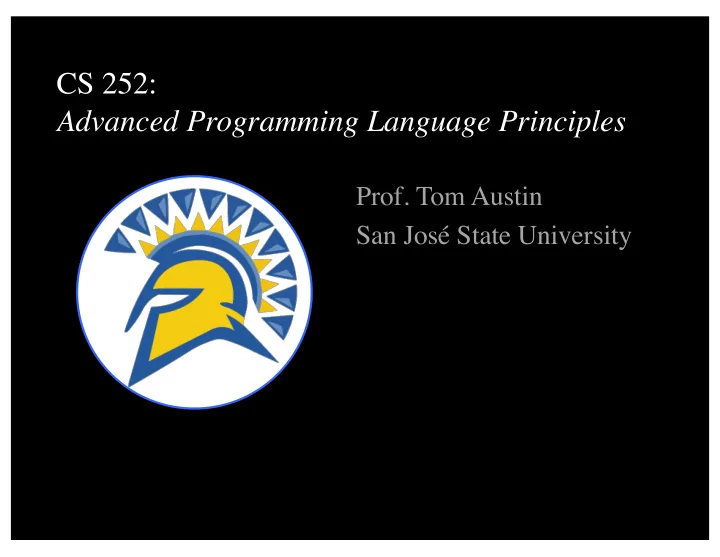

CS 252: Advanced Programming Language Principles Prof. Tom Austin San José State University
What are some programming languages?
Taken from http://pypl.github.io/PYPL.html January 2016
Why are there so many?
Different domains
Different design choices • Flexibility • Type safety • Performance • Build time • Concurrency
Which language is better?
Good language features • Simplicity • Readability • Learn-ability • Safety • Machine independence • Efficiency
These goals almost always conflict
Conflict: Type Systems Stop "bad" programs … but ... restrict the programmer
Why do we study programming languages?
For undergrads: to warp their minds
Objectives for grad students: • Understand advanced language features • Evaluate different features • Choose the right language • Understand formalisms
The "Blub" paradox Why do I need (monads, closures, type inference, metaobject protocols) ? My language doesn't have it, and it works just fine!!!
"As long as our hypothetical Blub programmer is looking down the power continuum, he knows he's looking down… [Blub programmers are] satisfied with whatever language they happen to use, because it dictates the way they think about programs." --Paul Graham http://www.paulgraham.com/avg.html
Languages we will cover (subject to change)
Theoretical foundations topics • Formal semantics • Type systems • Concurrency approaches • Metaprogramming • Security features
In this course, you will learn the practical and the theoretical
What are the PL issues of interest to industry?
Multi-core explosion
Big Data
Mobile Devices
Rise of the Web & Scripting Languages • Perl, Python, Ruby, PHP, JavaScript… • Flexible • Dynamically typed • Easy to get started • Minimal typing
Hello world in Java public class HelloWorld { public static void main(String[] args) { System.out.println("Hello World!"); } } Hello world in Ruby puts "Hello World!"
What are the PL academics interested in? • Types • Types (OK, maybe a little • More types! more than that…)
Why are they different?
Major PL research contributions • Garbage collection • Sound type systems • Concurrency tools • Closures
But PL researchers have missed some areas of interest
Academia and industry: Idealized relationship Academics come up with brilliant ideas Academia shares its ideas with people in industry Engineers use these ideas to build great things
Actual relationship Academics share ideas with industry (2) Academics come up with ideas (1) Engineers use these ideas, incorporating their own ideas and experiences (3)
Actual relationship Academics share ideas with industry (2) Academics come up with ideas (1) Sometimes they don't work out well (4) The cycle continues (6) Academics learn from the experience of engineers (5)
To participate in this discussion, you must understand formal semantics .
Programs that manipulate other programs • compilers & interpreters • JavaScript rewriting • instrumentation • program analyzers • IDEs
Sharing ideas unambiguosly • ECMAScript committee • Highlight issues early in the design • Prove that a language supports a given property
Three approaches to semantics • Operational – big-step – small-step • Axiomatic • Denotational
Now we can determine in some objective sense whether a language feature is "good".
Administrative Details • Green sheet available at http://cs.sjsu.edu/~austin/cs252- fall17/greensheet.html. • Assignments will be submitted through Canvas (https://sjsu.instructure.com/) • Academic integrity policy: http://info.sjsu.edu/static/catalog/integrity.html
Schedule • Greensheet: tentative schedule • Official schedule on Canvas • Late homeworks will not be accepted • Check the schedule before every class • Check the schedule before every class • And finally, CHECK THE SCHEDULE BEFORE EVERY CLASS.
Prerequisites You should be comfortable with: • Functional programming • Mathematical notation If you are not sure, please see me
Resources http://eloquentjavascript.net All available http://learnyouahaskell.com/ online!!!
Grading • 30% -- Homework • 20% -- Midterm • 20% -- Final • 20% -- Project • 10% -- Labs Open-ended.
Labs • Graded complete/incomplete • I will look at them • I might give feedback • May show up on exams
Office hours • MacQuarrie Hall room 216. • Mondays/Thursdays noon-1pm. • No office hours September 7th or 11th. • Also available by appointment
Haskell
Haskell is purely functional • We define "what stuff is" • No side effects • Referential transparency You can replace an expression with its value and you won't change anything.
Wait, no side effects?! How is that possible?
Haskell & side effects • Haskell functions can have side effects – e.g. file I/O • BUT, pure functions can't call functions with side effects
Haskell supports type inference
Some languages have explicit types // Java code String foo(int i) { String s = "hello " + i; return s; }
"Scripting languages" use dynamic typing // Ruby code def foo(i) s = "hello #{i}" return s; end Duck typing
"Duck typing" is flexible but not safe
In Haskell, you do not need to declare types; the compiler deduces them
Haskell supports lazy evaluation • Results not calculated until needed. • Can represent infinite data structures.
Lazy Example Haskell interactive mode: *Main> let oddNumbers = [1,3..] *Main> take 5 oddNumbers [1,3,5,7,9]
Before next class • Install Haskell from http://www.haskell.org/platform/contents.html • Read chapters 1-3 of "Learn You a Haskell". • Read C.A.R. Hoare’s “Hints on Programming Language Design” and write a short summary of his key points. http://i.stanford.edu/pub/cstr/reports/cs/tr/73/4 03/CS-TR-73-403.pdf
First homework due September 5th • Available in Canvas. – Alternately, see http://www.cs.sjsu.edu/~austin/cs252- fall17/hw/hw1/ • Get started now!
HW1 Overview Won't public class Test { compile! public void main(String[] args){ System.out.println( 999999999999999999999 * 2); } }
With Haskell, there is no issue: $ ghci ... Prelude> 999999999999999999999*2 1999999999999999999998
In this assigment, you will build your own BigNum module.
Haskell support. Have you tried converting tabs to spaces?
Recommend
More recommend